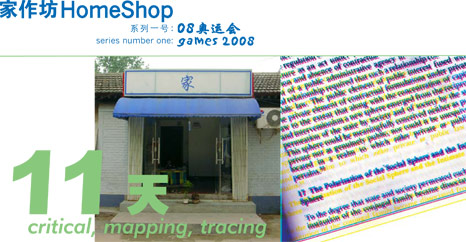
HomeShop invites Beijing’s Critical Reading Group to discuss two readings: Doina Petrescu’s “The Indeterminate Mapping of the Common” [download PDF here] and a selection from The Structural Transformation of the Public Sphere by Jürgen Habermas. The Habermas chapter, entitled “The Polarization of the Social Sphere and the Intimate Sphere” [download PDF here], didn’t make it to the discussion for reasons of dryness and tardiness, but in about three hours, the group manages to make it through the difficulties of defining a trace, Shaanxi Mo King buns, mapping China, a bit of beer & sake and a curious visit from the local police.
the notes below are simple tags to help you find your way —- the meeting in full is recorded below; skim through and hopefully find something interesting for you, or try playing them all at once and listen to the signal-to-noise ratio…
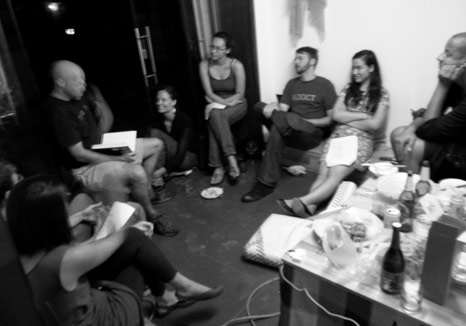
ON “THE INDETERMINATE MAPPING OF THE COMMON” | 3′ 23
contradicting, controversy of social mapping, a solipsistic position, Deligny, “the marker of a hidden ontological data”, do they share that relationship with the people imbuing meaning into their normative behaviours?, common to him, loss when you bring in language, discursive things…
MAPPING and TRACING | 7′ 11
GPS versus tracing, locative mapping versus tracing as invocation of essence, tracing has no purpose as such, tracing as the “way of doing it”, intention, Situationist, surprising within everyday life, not about finding something extraordinary, mental maps, how people live space, a minefield of gestures, a social mapping entanglement, ontological presence that you can’t really touch, anthropomorphism, common ground, tracing as creative process, anthropological process, fraught with danger, Sichuan, daily subjectivities within a larger urban plan, practical application, their locomotion, more aesthetic than logical, magnetic waves…
A LATECOMER, INTRODUCTIONS | 4′ 27
as little disturbance as possible, bad theory joke, angie – california, berkley, arts, bea – swiss, phd, geography, anthropology, urban planning, sean – toronto, phd, critical sports theory, olympics, collin – colorado, caijing, not where my interests are exactly, julia – contemporary art history, southern california, chinese, three shadows, elaine – texas, artist, freelancing, hence this, chris – artist, brooklyn, shanghai, theory, hanora – consulting, also not my main area of interest, matthew – long walks on the beach, capricorn, photographer, film, documentary, we’ve been on and off for awhile…
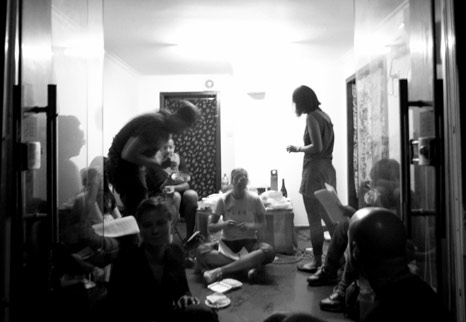
BALL, ANOTHER ARRIVAL | 4′ 06
Deligny, aqueducts, Berkley cognitive science professor, Himalayan graphic image of ball rolling forward, Buddhist monks, physical difference in brains, gravitational differences, dirty your floor, katie – come with duck and things, awkward being in the middle, other vegetables, open the sake, have at it, that’s all i’ve got, i like your haircut, rain, panic, panic, anyway…
THE OTHER | 10′ 12
theories of gravity, Tibetan monks, post-structuralist utilization of the Other, all this other without a kind of an object, autistic kids and Tibetan guys, rationalist flaw, let’s find an Other, ben stiller, line of crisis of modernity, our cities are poorest, flexible spaces, borders keep moving, the softness of cities has come to the fore, meditating, Edward Said’s “Orientalism“, hegemonic white male, Benedict Anderson‘s flaw, concrete Marxist ideals, is it a flaw or a mechanism to understand, language inherently leads to Otherness, polarizing nouns, Deligny breaking down polarization, everyday dispositions, a bridge, tracing that evokes a common space of understanding, describing, the limitations of the cartographic model, alternative models, trace as action, intense attention to something else without explaining, “a seeing that is not related to thinking, a gaze which does not reflect”, shooting for something passive, describe something in its own terms, ton of criticism, not completely there…
DEFINING MAPPING AND TRACING | 9′ 58
weakness of this article, juxtaposition, boundaries not clear, GPS locative mapping versus non-intentive walking, leaving realm for possibility in the act of doing, subjective process, walking as beginning of architecture, gesture as beginning of utterance, speech, writing, tracing as embodied communication, trace to map is shift of sensory focus to intense bias of visual, corporeality, knowing oneself in the world, trace as remnant, left behind, pinpointing, everyone in this room is constantly tracing, tracing as production of space, GPS is inherent map, imposing trails upon places already there, walking through this room, remainders, plotted footprints, embodied act becomes a leftover, mapping as judgmental or critical, tracing ontological, mapping and language, deterministic, mapping as reflexive practice, mapping: scopophilic, hegemonic, totalizing, problematic, tracing: nice, soft, centering closer to the abstract, foucault, approaching the liminal?, the approximation of a definition, never access through language, Deleuze & Guattari, affect before thought, codify affect to thought and thought to language, tracing as affective, embodied experience, codified in language, another way of saying mapping…
THIS PROJECT, THIS SPACE, COMMON SPACE, ETC. | 9′ 27
different activities or events, subversions or interventions, my own meanings of the city at this time, documentation without intent, no ideal visualization, what’s going on in this city, Deligny inserting himself, what’s the trace for you here?, opening ceremonies, clique-ing inside, screen as boundary that is crossed, separation of the social networks made possible by this event, blurring of public and private space in Chinese society, attempt to trace or document, Olympics as grid, imposition upon city and people affecting everyday life level, Petrescu’s common space, lack of ability to describe the ontological, an active process, resting on vagueness, syntax, argument on links, tracing or mapping out of ethnographies, about the author themselves over their subject of ethnography, what body position is supposed to be, starting with a conclusion, motive or desire to embark upon a project, “another history of architecture —- one which is not that of settlements, cities and buildings made of stones but of movements, displacements and flows….“
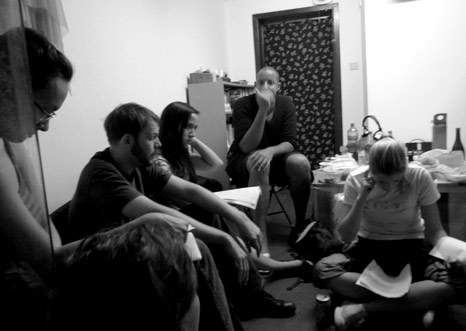
TRACING BEIJING OLYMPICS, 警察来了, 就是朋友 | 8′ 16
Does tracing have anything to do with how Beijing was radically altered in advance of the Olympics?, Yuan, Ming, Qing, buildings wiped out, how modern Beijing has been built, tracing like breathing, because the development’s there I go to it, pathways through hedges, desire paths, Beijing is meant to control that, you can never control that, space for improvisation, mapping consciousness versus social consciousness, opposite the hutong vibe, tracing in hutongs, structure businesses, houses, lives, dream of the architects, 没有,就是一些朋友过来吃饭,在北京工作,这个我帮一个朋友, did someone call?, the station’s just down the street, maybe we just carry on like everything’s cool, an example of control, exercise machines, follow that grid exactly, social control built, who you guys were, state-prescribed exercise equipment, 20th century history of hutongs not existing prior to 1949, talking about fashion or something, multiplying things over…
AFFECT , COMMUNITY, INDETERMINACY | 7′ 49
map can affect the tracing, bear with me here, subway lines, cigarette butts, can tracing affect the map, perspective and approach, subway lines along desire paths, number 5 lines didn’t lead to anywhere, developers knew beforehand, not helpful to binarize mapping and tracing, observation and phenomenology, a give and take, growth in a strange way, human experience, learn anew, “The question addressed to architects, urban planners and placemakers is how to operate with a space which is traced at the same time as it is lived and how to use this tracing to understand and eventually create more relationships between those who inhabit it. How to allow them to have access to and decide about their common tracing which is also the condition of their indeterminate community?“, productivity of a tracing, relationships, economic development, where people should go, where can most money be made, indeterminate community as opposed to creating a built environment, foster indeterminancy while meeting needs, the agenda of positive goal, the “inoperable community“, “the unavowable community”, Nancy and Agamben, how do we create community that embraces otherness, that eliminates problems of language, a model for how we can create this idea of community, moving against Empire, not so simple as embracing hybridity, the postmodern question…
COMMUNITY, CHINA, URBAN ENVIRONMENT | 14′ 42
what’s impossible about community in Beijing, generational differences: Long March survivors, Cultural Revolution generation, first benefits of kaifang, one-child only generation, communications technology generation, how do you resolve disjointing ideas of what community is, what recreation is, fundamental approach to living, what is comfort, what is entertainment, nationalism at its highest, what happens after the Olympics, falls out over the next year, huge economic fallout, currency fluctuations, Chinese community formed on basis of socio-economics versus family, growing middle class, growing upper class, more than any top-down policies, do away with the hukou system entirely in the next few years, 1,000,000 empty apartments, 15 new Shanghais across the interior, 90 new airports, huge headwall in terms of natural resources, employment, pollution, energy use…, the world can’t handle it, 1.2 billion in China living like we do in the U.S., the horror of seeing another United States, consumer model carrot of the Communist Party, house with 3 cars, all the way from Sichuan to work, migrant workers in Africa, promise of increased material wealth, social unrest in countryside, Henan, Hubei, their vision of what it means to be modern and successful, xiaokang shehui, top-down vision, Three Moderns: sewing machine, refrigerator, tv second wave, cell phone third wave, directly equated with happiness, what material wealth means, three C’s in Japan, equal rise in urban and rural dwellers over last 20 years, but skyrocket of urban in last five years, decline just outside of major metropolitan areas, living on site right off Wangfujing, things just don’t seem to be improving, not reported widely at all, trying to negotiate with 15 new Shanghais, exacerbate all the existing problems, Neville Mars’ new book, every book is “this is China’s downfall” or “this is China’s great rise”, high levels of politburo, how is policy implemented in such a fractured manner, rethinking how people live in urban areas, disaster waiting to happen, that book is big…
EVEN-ING, DEVELOPMENT, CHINA AND AMERICA | 11′ 07
world is becoming more even, places look like Nairobi, shoddy worksmanship, infrastructure, Lagos as THE model megacity, general call for alarm, what’s new, every emerging developing nation, an egalitarian peak, a lie, less mobility now than before, 1968 was last year in U.S. where blue-collar worker could sustain a family of five in comfortable middle class lifestyle, accumulation of capital among top 2%, Guilded era in the states, shifting ways in which we assess, we’re making new maps by talking about it new ways, money being available for everyone, renting, property ownership will evaporate, easy for Chinese to get a loan and by a house, China’s American dream, ethnic differences with socio-economic differences, going to hell, we are setting a horrible precedent for the developing world and the developed world, clean-up, rate of growth, Chongqing, Guangzhou, Pearl River Delta, runaway rapacious development, manufacturing sector dying, biggest open pit in China, Tianjin waterfront like Chicago, river-cruise in Chongqing, a complete mess…
CHANGE, PRECEDENT, ADVERTISING, CONSUMPTIVE PATTERNS | 12′ 29
post-War, west Virgina, where my people are from, the ‘Burg, today very difficult for people to buy a home, terrible precedent, cusp of massive wealth transfer, dying babyboomers, money you didn’t work for, young people of floating network, media perpetuation, service and information economy, how does the precedent change?, a missing piece, production and consumption habits, avoiding talking about China as a monolith, splintered, how an individual will accept, opportunity to change things or for further decadence?, is China really looking to America as as an example, consumption, Hong Kong developers, healthcare system based on U.S. system, countryside, basic medical care yes, emergency response is bad, advertising, consumptive patterns are what will be really detrimental, extremely misleading, setting into motion fast consumer cycles, apple juice, technology, two-month cell phones, clothing, 50’s American, education, willingness to be swayed, propaganda, global production of advertising, new millenium techniques with 1950’s propaganda, a technique that works gets disseminated in a month, black & white televisions, separation from reality, no conclusion…
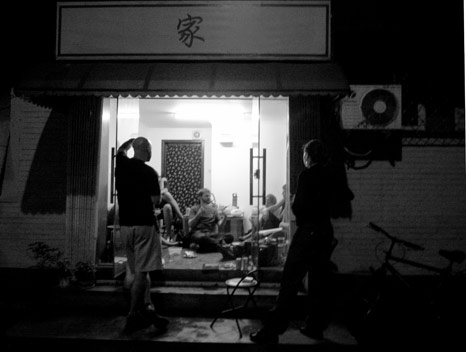
This activity of the HomeShop Games 2008 project was organised by HomeShop and Angie Baecker. Thank you to all who showed up despite the summer rains…

 时间 posted on: 26 August 2008 |
时间 posted on: 26 August 2008 |  发布者 author:
发布者 author: 
 分类 filed under:
分类 filed under:
August 26th, 2008 - 23:25
[…] Original post by e […]
August 27th, 2008 - 04:05
[…] Here are some questions that we could relate to the tracing issues we talked about yesterday… […]
August 31st, 2008 - 10:52
While the autistic moves in the interstices between affect and sensation to trace underground water systems or electromagnetic fields, have we not witnessed the same occurring in particular contexts through history with “normal” populations? For example, I am thinking of the explorer who seeks water with a hickory switch divining rod. Or the eccentric on the beach who seeks to uncover the treasure of eras past with a metal detector (though they will tell you that process rather than outcome offers the amusement). Or, in a more contemporary sense, I am fascinated by laptop-wielding cultural producers who carefully wander about a quasi-public space in an attempt to divine a steady wireless internet signal.
In each of these examples the subject, not unlike the autistic, is attempting to locate and move with/in a flow. The difference is that the modality which permits this flow-movement is a cyborgian extension of the body in some combination of material and immaterial.
This leads to certain consequences: identification with the flow for the cyborg lies no longer between affect and sensation, as with the autistic, but rather between sensation and thought. In turn, the general embodiment of the autistic yields to a focusing or heightening of the tactile sense for the cyborg, with acoustics (metal detector) and/or optics (wireless connectivity) playing complementary roles. This is a very different form of cyborgian movement than we see, for example, with GPS technologies and tracking.
A number of questions present themselves, such as: What sorts of opportunities for tracings emerge as our cyborgian technologies become more fully integrated with the body? What shifts in sensory ratio occur as this integration takes place? How do the immaterial elements of these new integrations allow for sharing with the “other”? And like the autistic, will we move further up the spectrum, so to speak, from thought to sensation to affect in our embodied understanding and identification with a flow?
September 2nd, 2008 - 18:05
[…] politics and our subjectification as citizens can never be merely aside, can we affect-ively trace a new map […]
September 3rd, 2008 - 17:56
interestingly enough, maps and tracings also come up in deleuze and guattari (“make a map, not a tracing”; the rhizome), and i wonder whether they can help us think further about this:
“what distinguishes the map from the tracing is that it is entirely oriented toward an experimentation in contact with the real. the map does not reproduce an unconscious closed contact with the real. the map does not reproduce an unconscious closed in upon itself; it constructs the unconscious. it fosters connections between fields, the removal of blockages on bodies without organs, the maximum opening of bodies without organs onto a plane of consistency. it is itself a part of the rhizome. the map is open and connectable in all ot is dimensions; it is detachable, reversible, susceptible to constant modification. it can be torn, reversed, adapted to any kind of mounting, reworked by an individual, group, or social formation. it can be drawn on a wall, conceived of as a work of art, constructed as a political action or as a meditation. perhaps one of the most important characteristics of the rhizome is that it always has multiple entryways; in this sense, the burrow is an animal rhizome, and sometimes maintains a clear distinction between the line of flight as passageway and storage or living strata (cf. the muskrat). a map has multiple entryways, as opposed to the tracing, which always comes back “to the same.” the map has to do with performance, whereas the tracing always involves an alleged “competence.”” (from deleuze & guattari, a thousand plateaus: capitalism and schizophrenia)
this seems to be almost the opposite of doina petrescu’s understanding of tracing.. i think she might be referring more to deligny’s tracing which is quite a different process than the mere outlining of something already existing (as in using tracing paper to draw over the lines of something).
i don’t know how much language also plays into this (what are the terms and their connotations in french?) but maybe instead of what they mean, it’s more interesting to think about what mapping and tracing do, what they can do..
can a map include both what’s there and what yet isn’t – the unseen, the unrealized, hidden conditions, latent possibilities, desires? can a map include the unmappable?
instead of a map as a finished product, a bird’s-eye view on something already fixed, can we think of mapping as a process, a political tool that can help us situate and orient ourselves inside an unrepresentable totality?